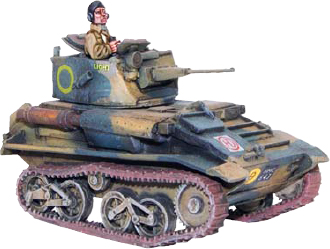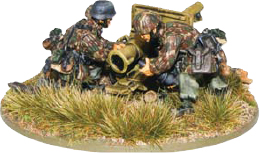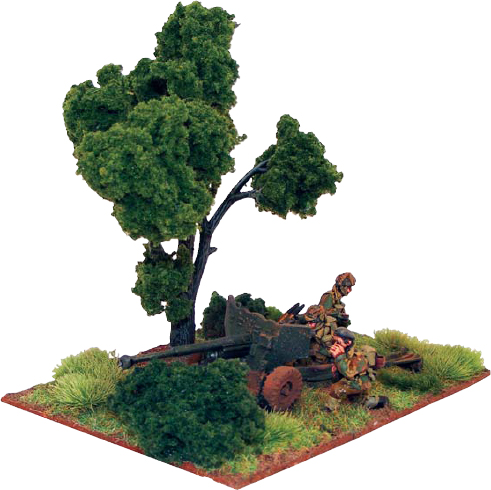

British troops assaulting Japanese bunkers, by Peter Dennis © Osprey Publishing Ltd. Taken from Campaign 229: Kohima 1944.
This section includes army lists for the forces of Britain and Commonwealth, Germany, the Soviet Union and the United States of America.
Each list includes entries for a variety of infantry, artillery and vehicle units. Gaming values, armament details and any individual rules needed during play are included as part of each entry. Each unit is given a basic cost in requisition points together with further costs for additional equipment and other options.
The lists given here do not pretend to be exhaustive or to cover every theatre of the war, every kind of vehicle and every weapon – rather they are basic lists that cover the essential formations and weapons of each of the armies concerned. A series of separate Bolt Action supplements provides detailed and definitive army lists that supersede these lists and extend the armies covered into different theatres of the war and specific campaigns. The lists given here are generalised to a degree, and are based upon armies of the later part of the war – 1944 and 1945. This allows for a good variety of equipment and tanks. That does not mean that we cannot fight actions between the Vichy and Free French in the Middle East in 1941 – for example – but limited space obviously prevents us covering every campaign in detail in this book. Our intention is to offer both printed supplements for the major combatant nations, and appropriate online support for minor contributors and specialised theatres.
Many players will have a good idea of how the real formations represented by our armies were organised. Others may be less familiar with the structure of World War II armies and the way in which they fought. The description given is obviously a fairly broad-brush summary, and different armies varied considerably in practice as might be readily imagined. However, it will serve to give an idea about how to go about putting together a wargames army for the tabletop battlefield.

British MkVIc light tank
Broadly speaking the smallest infantry unit was the squad, or section, comprising around ten men commanded by a noncommissioned officer (NCO) such as a sergeant or corporal. A squad could be split into smaller groups or fire-teams, often comprising one group based around a light machine gun, and another based around rifle-armed troops. Squads were often under-strength due to casualties. In our lists infantry squads can usually be fielded at between five and twelve men, allowing a player to deploy them as smaller five-man teams, under-strength squads or squads at full strength.
A platoon was the next level of organisation. It consisted of two to five squads, for a total of roughly twenty to fifty men. It was commanded by the lowest rank of commissioned officer, a lieutenant or the equivalent, who might be assisted by a senior or platoon sergeant in some cases.
A company is the largest level of organisation likely to be represented in our game. It consisted of between two and eight platoons, for a total of roughly one hundred to two hundred men. A captain or sometimes a major would command a company, and a senior NCO or warrant officer such as a company sergeant major might assist him.
The first thing to consider when assembling a force is the infantry. It’s best to begin with infantry squads and pick two to five squads of roughly ten men. Three squads is a good basic force to start with.

Fallschirmjäger 10.5cm LG40 recoilless gun
TOP SECRET
Just for the sake of curiosity, you might like to know that the structure continues with:
• Battalion. Two to six companies (up to over 1,000 men). Commanded by a lieutenant colonel.
• Regiment. Two or more battalions (up to over 2,000 men). Commanded by a colonel.
• Brigade. Two or more regiments (up to 5,000 men). Commanded by a brigadier general (one-star).
• Division. Two to four brigades (up to 15,000 men). Commanded by a major general (two-stars).
• Corps. Two or more divisions (up to 45,000 men). Commanded by a lieutenant general (three-stars).
• Army. Two to four corps (up to 200,000 men). Commanded by an army general (four-stars).
• Army Group. Two or more armies. Commanded by a field marshal or five-star general.
After the infantry squads you will find a list of heavy weapons teams including machine guns, mortars, and portable anti-tank weapons such as bazookas. In a real army these teams would form specialised heavy weapons platoons or would be held at HQ level. Typically there would be something like three infantry platoons to one heavy weapons platoon. It makes good sense to keep a similar proportion in the game, with one mortar team, one machine gun team, one anti-tank team, flamethrower team, sniper team for every three full-strength infantry squads. If you include one each of every heavy weapon for every three infantry squads this still is a very high concentration of heavy weapons compared to a real battlefield, but it makes for a more interesting game and still maintains a reasonable relationship between the number of heavy weapons and men.
If three infantry squads represent a platoon, it makes sense to have a lieutenant to command it. Of course, the company’s captain might have come down to keep a close look at this part of the engagement, so he could be fielded in addition to (or instead of) the lieutenant if desired. He will prove more useful in larger games with company-sized forces.
Medics were normally one per platoon, so once again if one is included it will feel about right. Forward observers were less common, and it would be therefore best to select no more than one for the army unless it is a very large game, in which case a force might include one of each type.
Anti-tank guns and howitzers, as well as combat vehicles like tanks and armoured cars, were normally assigned to support infantry by high command when necessary, so on the level of our game they should be a comparably rare sight on the battlefield. However, a game devoid of tanks and big guns would be a dull affair, so we are prepared to accept that our part of the battlefield just happens to be where the opposing tanks and armour are concentrated. We recommend using a maximum of one tank, one other lightly armoured vehicle and one piece of artillery for every three infantry squads in your force.

Polish paratroopers prepare their 6 pdr anti-tank gun for action
Transport vehicles (particularly soft-skins) are a bit more common and we’d happily include up to one such vehicle per infantry squad in addition to any other vehicles mentioned above.
Games significantly larger than our standard 1,000 requisition points would tend towards company-level actions and therefore it would make sense to include multiples based on the proportions discussed.
The following rules are a distilled version of the guidelines discussed above. They have been formalised with a view to putting together armies that are reasonably well balanced in play rather than being strictly based on historical formations. Sticklers who wish to follow the orders of battle for actual historical engagements are entirely welcome to do so of course; the purpose of these lists is to enable players who wish to do so to choose well-matched, competitive, and entertaining forces with which to play a challenging game.
A force must comprise one or more reinforced platoons picked from one of the four Army Lists. Each reinforced platoon is made up as per the table opposite.
When picking a force begin with the first reinforced platoon and start by fulfilling its minimum requirement of 1 lieutenant and 2 infantry squads. Once this is done, pick from the other units given until the total requisition value of your units reaches the agreed maximum value for the force or as close as you can get.
So long as you have sufficient points remaining, you can always stop at any stage and start again with a second reinforced platoon, and then a third, and so on, adding as many platoons as your points will allow.
Note that transports can always be included up to one vehicle for every infantry and artillery unit in the reinforced platoon. This enables infantry to be mounted into carriers if desired, HQ units to have jeeps or similar vehicles, and artillery and anti-tank guns to have prime movers.

| REINFORCED PLATOON | |
| 1 | Lieutenant – First or Second |
| 2 | Infantry squads |
| PLUS | |
| 0–3 | Infantry squads |
| 0–1 | Captain or Major |
| 0–1 | Medic |
| 0–1 | Forward Observer (either Artillery or Air) |
| 0–1 | Machine gun team |
| 0–1 | Mortar team |
| 0–1 | Sniper team |
| 0–1 | Flamethrower team |
| 0–1 | Anti-tank team |
| 0–1 | Field Artillery, Anti-aircraft or Anti-tank gun |
| 0–1 | Armoured Car |
| 0–1 | Tank, Tank Destroyer, Anti-aircraft vehicle or Self-propelled Artillery |
| 0–1 | Transport vehicle or tow (soft skins or armoured) per infantry and artillery unit in the reinforced platoon. |
It is perfectly possible to spend all the points available on one large reinforced platoon, or to buy several smaller reinforced platoons allowing for a higher proportion of specialised units. This is entirely up to the player, but always keep in mind that the total value cannot exceed the maximum total requisition points agreed for the force.
Eagle-eyed readers will notice that that Anti-aircraft guns are included in the force selection list but are not included in the army lists in this book. This is because these are specialised weapons and it was felt unnecessary to include them in the basic lists. However, they do appear in the various Bolt Action supplements and so have been included in the selection rules.